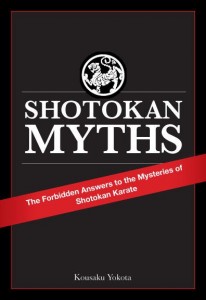Recently I wrote about Shihan Kousaku Yokota’s new book, Shotokan Myths. Well now it is available for purchase (details below). I have had some private correspondence with Shihan Yokota and there was one thing in particular that he said that I consider very important and I wanted to share with everybody. With so many “reality based” martial arts and the rise of mixed martial arts, many people have questioned the effectiveness and validity of the traditional martial arts. Many Japanese masters have been secretive or aloof and have not bothered to explain the finer points, keeping Westerns on a rather superficial level. I’ve seen some Japanese masters teach up in Scotland, UK, where they actually pretend that they can’t speak English properly when you know full well that they can (from people who have actually visited the masters own dojo).
I have to say that I do not believe this of all the Japanese masters, but certainly some are like it. Yet here we have a Japanese master at the very highest level who is not only wants to teach all that he knows, but is actually concerned that if he does not, that Karate will become obsolete. As I said before, although the book has “Shotokan” in the title, it should be of interest to other styles as well, especially those with Shotokan in their lineage.
Anyway, here in Shihan Yokota’s own words (and with his permission to reproduce it):
“I want to share the knowledge so that the western karate practitioners will see the “light” so to speak. There should not be so much of mysticism about Karate. Almost all the things can be fully explained. But it was easier for many “masters” to keep them as mysterious or “secret”. The fact is many “masters” did not know the answers or have the ability (or motivation) to explain them. Many Japanese instructors are afraid to speak up as that would reveal the inability of those masters or the organizations. It has been more than 60 years since shotokan karate was introduced to the western world. I believe it is about time somebody to speak up and let the western practitioners know it is ok to ask and challenge what you read or learn from the Japanese masters. Without this quest we cannot hope to improve karate and it will end up in a museum some day. Ossu”
ISBN #978-1-4568-0709-2 (Hard cover) US$29.99
#978-1-4568-0708-5 (Soft cover) US$19.99
You can order your copy now from the publisher, Xlibris:
• Phone (Toll Free): 1-888-795-4274
• Fax: 1-610-915-0294 or 1-610-915-0293
• E-mail: [email protected]
They will ship internationally (shipping charge will apply).
Extra note: I don’t know about other countries, but shipping and handling cost quoted for posting to the UK are extortionately high. I have asked Shihan Yokota to get Xlibris to confirm. However, Shotokan Myths is also available from Amazon in paperback or hardcover where S & H costs should be more reasonable from there.
UPDATE: You can now get it from Amazon:-
In the UK
In the USA



